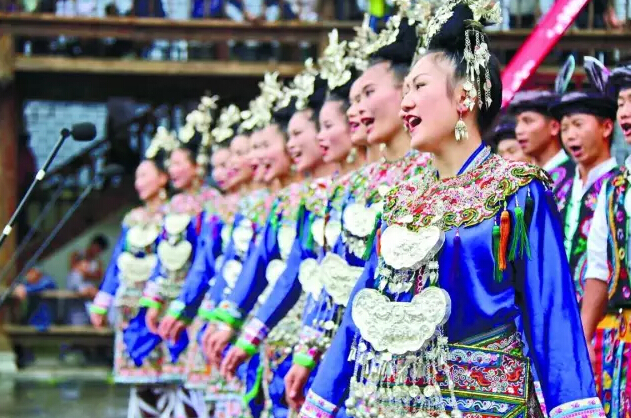The Legacy of Kam Grand Choir endures

Dong women perform the Kam Grand Choir in ethnic dresses. The Kam Grand Choir is a polyphonic singing style of the Dong ethnic people.
The Kam Grand Choir refers to a style of folk singing and its associated customs. It was created and passed down by the Dong ethnic people, who are also sometimes referred to as the Kam people, in southern China. These grand songs are a form of polyphonic, natural choir singing without a conductor or any accompaniment. Dong people are internationally renowned for singing melodious sounds of nature. In 2007, the Kam Grand Choir was enrolled in the national intangible cultural heritage list; since 2009, it has been listed by UNESCO as a world-class form of intangible cultural heritage.
The origins of Kam Grand Choir can be traced back to the Spring and Autumn and Warring States period. It has been passed down by oral instruction and rote memorization for 2,500 years. Although it carries the label of intangible cultural heritage of UNESCO, its future is still uncertain. Saving this form of music has become an urgent task.
Today, the Kam Grand Choir is mainly spread around the villages and towns of Liping, Congjiang and Rongjiang in Guizhou Province, and those of Sanjiang in Guangxi Zhuang Autonomous Region. This area represents more than 1,000 square kilometers but the population is only around 100,000 people.
“Even in this area, not everyone can sing the Kam Grand Choir,” said Deng Minwen, a research fellow at the Chinese Academy of Social Sciences, who specializes in the Dong ethnic minority.
There are three types of villages that still traditionally sing these choir performances.
Some villages have been influenced by the challenges of modernization and the choir has been confronted with the possibility it won’t be passed on to the next generation. Some villages are in remote regions with undeveloped transportation networks, so the old customs, such as singing the choir performances, have been well preserved. Some villages have received extensive support from the local government to build tourism regions and the choir performances have been commercialized.
In Liping County, Guizhou Province, Dong people represent 72 percent of the total population. Wu Zhicheng, a 69-year-old inheritor of this intangible cultural heritage who has been certified at the provincial level, recalled that in the 1980s, local people organized male and female singing teams during the slack farming season and visited other villages to sing performances aimed at finding a mate or making friends. He recalled that these visits were intended to promote friendship and exchanges, but now it is rare to see the choir in the village except during Spring Festival.
Because the ancient Dong people lacked a written language, the inheritance of grand songs depended on oral instructions from generation to generation. At present, Wu is working hard to collect, organize and write down Dong lyrics of grand songs in modern Chinese characters, and he has completed some manuscripts.
In Rongjiang County, the local government is attempting to revive the Kam Grand Choir by holding an annual singing competition. The competition attracts more than 2,500 participants every year and encourages local people to actively showcase their talents.
In 2014, Guizhou Province initiated a five-year action plan to protect the inheritance of the choir with a special fund. “Although the songs are very catchy, they still confront problems of popularization.” A local official indicated that people who don’t speak the Dong dialect cannot easily understand the lyrics, and also, those grand songs are monotone, which make them difficult for people to learn. However, the grand choir is bouncing back. Some villages are attempting to organize commercial singing groups and eventually make a good profit. A few adapted musical versions of classical grand songs are about to be shown on the stage in urban areas.
